Leading Lean Project Essay 2022
VerifiedAdded on 2022/09/29
|12
|4326
|30
Essay
AI Summary
Contribute Materials
Your contribution can guide someone’s learning journey. Share your
documents today.
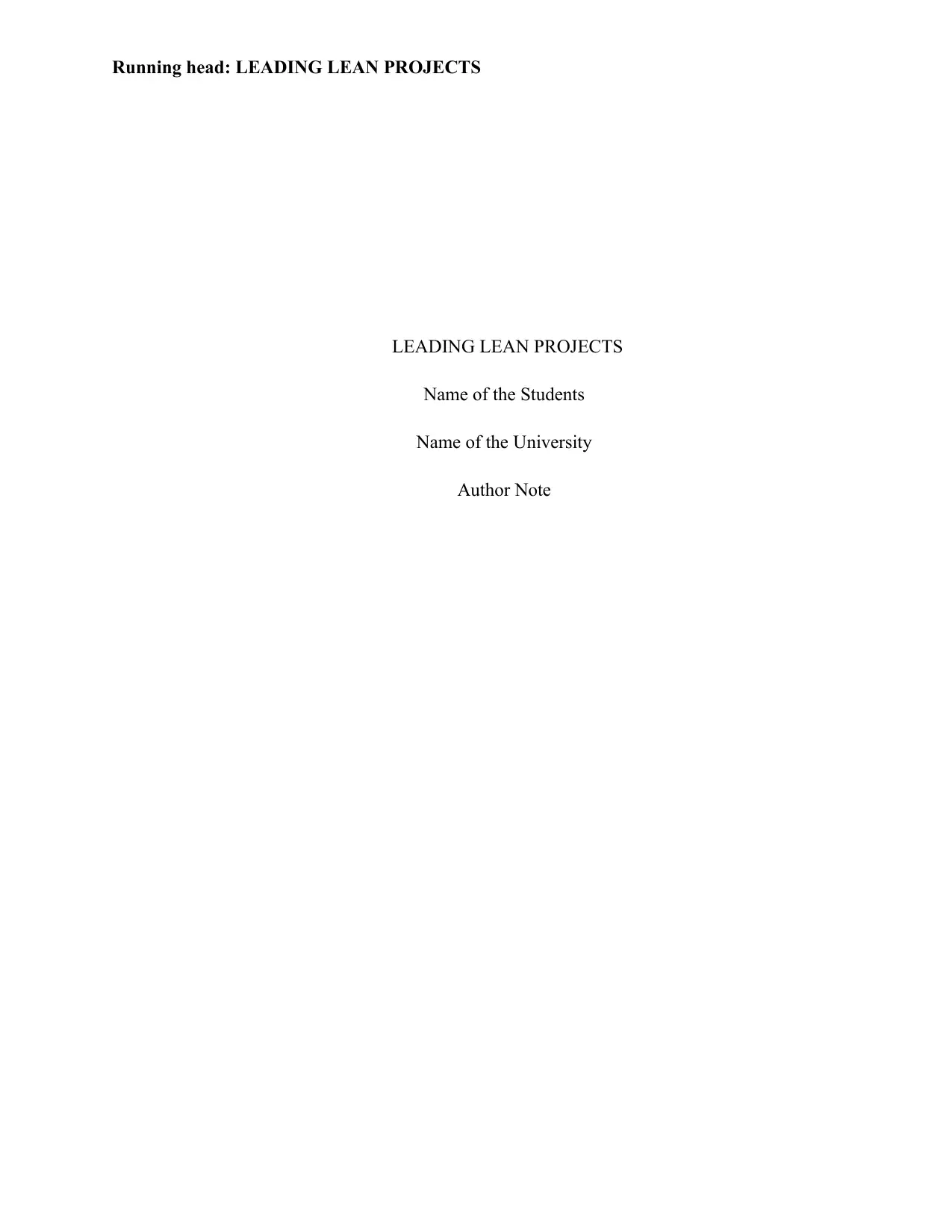
Running head: LEADING LEAN PROJECTS
LEADING LEAN PROJECTS
Name of the Students
Name of the University
Author Note
LEADING LEAN PROJECTS
Name of the Students
Name of the University
Author Note
Secure Best Marks with AI Grader
Need help grading? Try our AI Grader for instant feedback on your assignments.
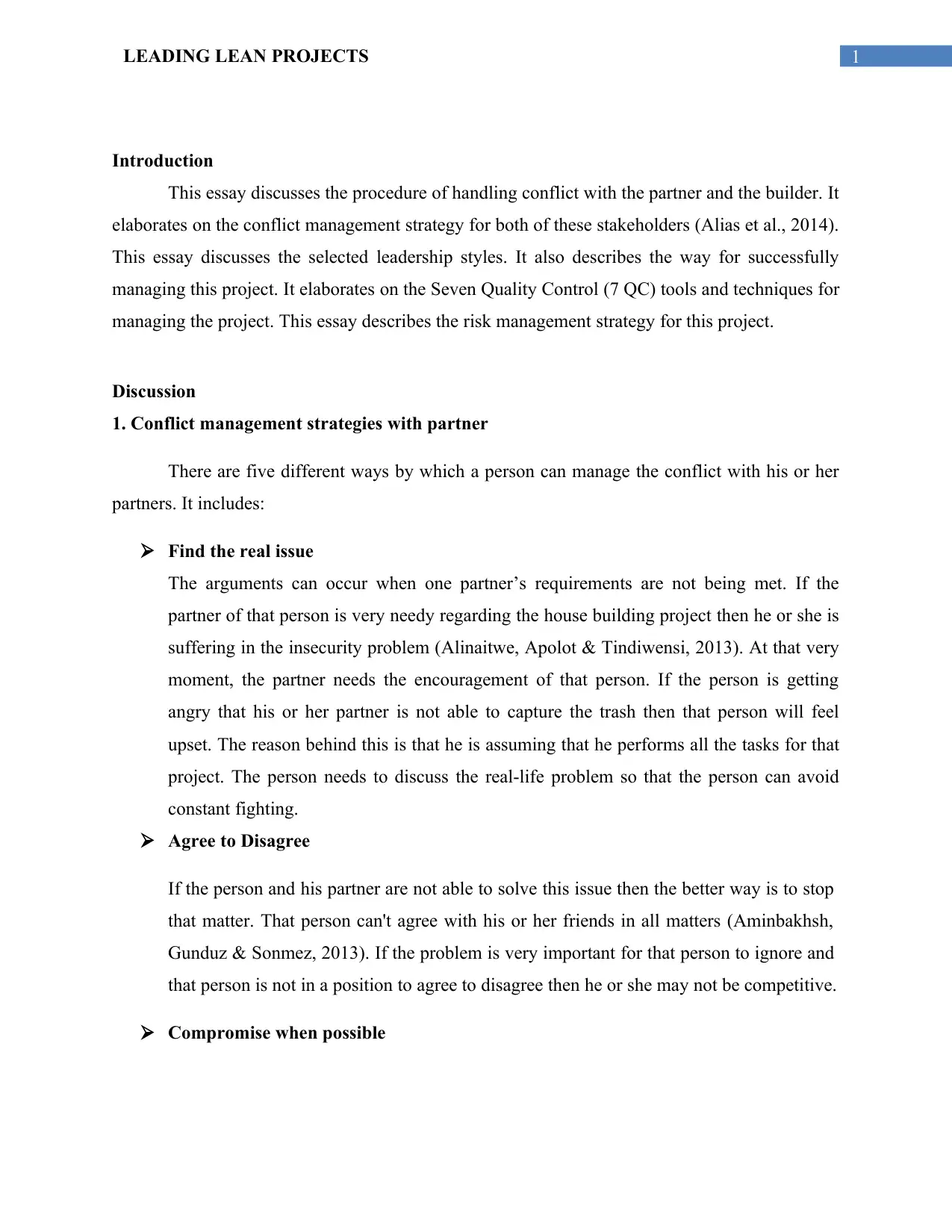
1LEADING LEAN PROJECTS
Introduction
This essay discusses the procedure of handling conflict with the partner and the builder. It
elaborates on the conflict management strategy for both of these stakeholders (Alias et al., 2014).
This essay discusses the selected leadership styles. It also describes the way for successfully
managing this project. It elaborates on the Seven Quality Control (7 QC) tools and techniques for
managing the project. This essay describes the risk management strategy for this project.
Discussion
1. Conflict management strategies with partner
There are five different ways by which a person can manage the conflict with his or her
partners. It includes:
Find the real issue
The arguments can occur when one partner’s requirements are not being met. If the
partner of that person is very needy regarding the house building project then he or she is
suffering in the insecurity problem (Alinaitwe, Apolot & Tindiwensi, 2013). At that very
moment, the partner needs the encouragement of that person. If the person is getting
angry that his or her partner is not able to capture the trash then that person will feel
upset. The reason behind this is that he is assuming that he performs all the tasks for that
project. The person needs to discuss the real-life problem so that the person can avoid
constant fighting.
Agree to Disagree
If the person and his partner are not able to solve this issue then the better way is to stop
that matter. That person can't agree with his or her friends in all matters (Aminbakhsh,
Gunduz & Sonmez, 2013). If the problem is very important for that person to ignore and
that person is not in a position to agree to disagree then he or she may not be competitive.
Compromise when possible
Introduction
This essay discusses the procedure of handling conflict with the partner and the builder. It
elaborates on the conflict management strategy for both of these stakeholders (Alias et al., 2014).
This essay discusses the selected leadership styles. It also describes the way for successfully
managing this project. It elaborates on the Seven Quality Control (7 QC) tools and techniques for
managing the project. This essay describes the risk management strategy for this project.
Discussion
1. Conflict management strategies with partner
There are five different ways by which a person can manage the conflict with his or her
partners. It includes:
Find the real issue
The arguments can occur when one partner’s requirements are not being met. If the
partner of that person is very needy regarding the house building project then he or she is
suffering in the insecurity problem (Alinaitwe, Apolot & Tindiwensi, 2013). At that very
moment, the partner needs the encouragement of that person. If the person is getting
angry that his or her partner is not able to capture the trash then that person will feel
upset. The reason behind this is that he is assuming that he performs all the tasks for that
project. The person needs to discuss the real-life problem so that the person can avoid
constant fighting.
Agree to Disagree
If the person and his partner are not able to solve this issue then the better way is to stop
that matter. That person can't agree with his or her friends in all matters (Aminbakhsh,
Gunduz & Sonmez, 2013). If the problem is very important for that person to ignore and
that person is not in a position to agree to disagree then he or she may not be competitive.
Compromise when possible
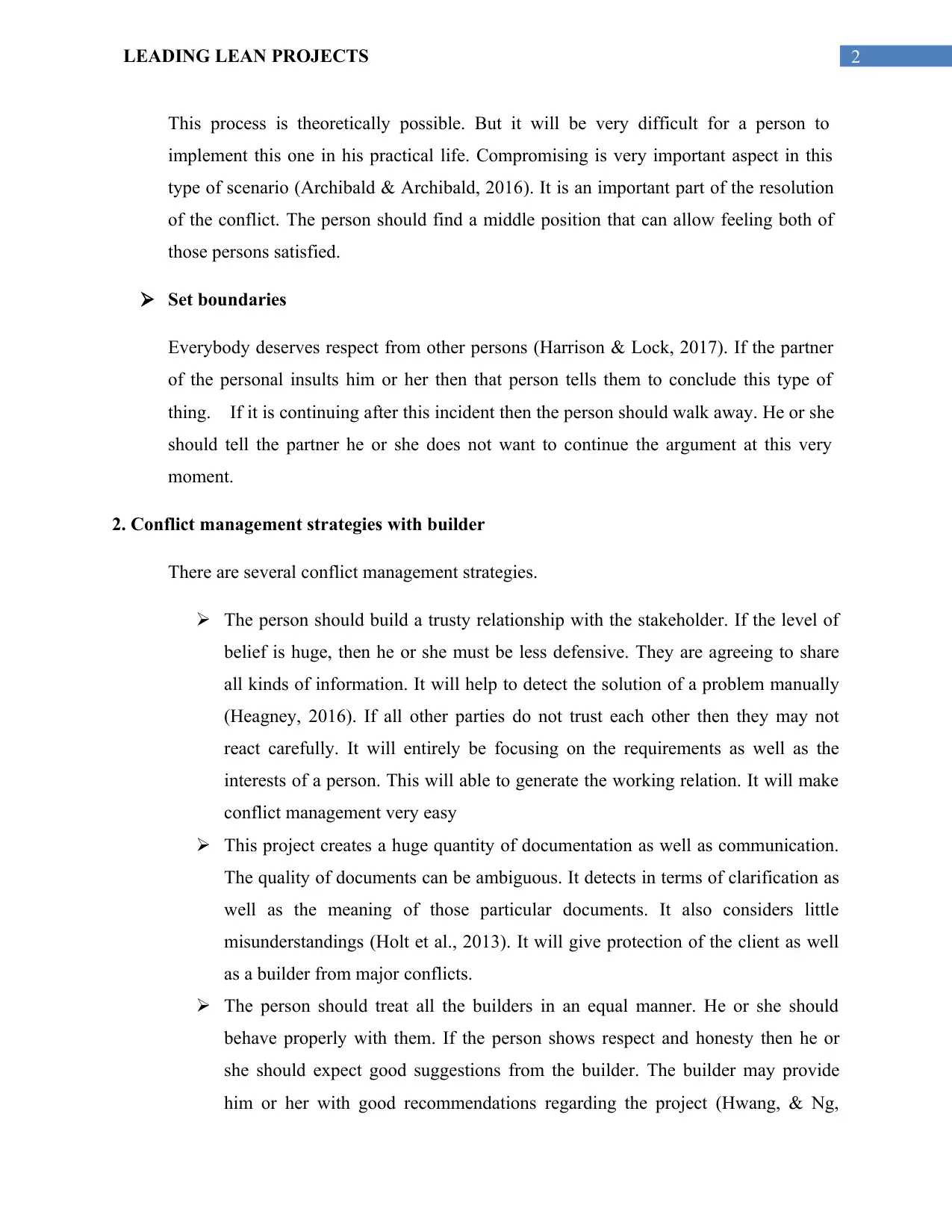
2LEADING LEAN PROJECTS
This process is theoretically possible. But it will be very difficult for a person to
implement this one in his practical life. Compromising is very important aspect in this
type of scenario (Archibald & Archibald, 2016). It is an important part of the resolution
of the conflict. The person should find a middle position that can allow feeling both of
those persons satisfied.
Set boundaries
Everybody deserves respect from other persons (Harrison & Lock, 2017). If the partner
of the personal insults him or her then that person tells them to conclude this type of
thing. If it is continuing after this incident then the person should walk away. He or she
should tell the partner he or she does not want to continue the argument at this very
moment.
2. Conflict management strategies with builder
There are several conflict management strategies.
The person should build a trusty relationship with the stakeholder. If the level of
belief is huge, then he or she must be less defensive. They are agreeing to share
all kinds of information. It will help to detect the solution of a problem manually
(Heagney, 2016). If all other parties do not trust each other then they may not
react carefully. It will entirely be focusing on the requirements as well as the
interests of a person. This will able to generate the working relation. It will make
conflict management very easy
This project creates a huge quantity of documentation as well as communication.
The quality of documents can be ambiguous. It detects in terms of clarification as
well as the meaning of those particular documents. It also considers little
misunderstandings (Holt et al., 2013). It will give protection of the client as well
as a builder from major conflicts.
The person should treat all the builders in an equal manner. He or she should
behave properly with them. If the person shows respect and honesty then he or
she should expect good suggestions from the builder. The builder may provide
him or her with good recommendations regarding the project (Hwang, & Ng,
This process is theoretically possible. But it will be very difficult for a person to
implement this one in his practical life. Compromising is very important aspect in this
type of scenario (Archibald & Archibald, 2016). It is an important part of the resolution
of the conflict. The person should find a middle position that can allow feeling both of
those persons satisfied.
Set boundaries
Everybody deserves respect from other persons (Harrison & Lock, 2017). If the partner
of the personal insults him or her then that person tells them to conclude this type of
thing. If it is continuing after this incident then the person should walk away. He or she
should tell the partner he or she does not want to continue the argument at this very
moment.
2. Conflict management strategies with builder
There are several conflict management strategies.
The person should build a trusty relationship with the stakeholder. If the level of
belief is huge, then he or she must be less defensive. They are agreeing to share
all kinds of information. It will help to detect the solution of a problem manually
(Heagney, 2016). If all other parties do not trust each other then they may not
react carefully. It will entirely be focusing on the requirements as well as the
interests of a person. This will able to generate the working relation. It will make
conflict management very easy
This project creates a huge quantity of documentation as well as communication.
The quality of documents can be ambiguous. It detects in terms of clarification as
well as the meaning of those particular documents. It also considers little
misunderstandings (Holt et al., 2013). It will give protection of the client as well
as a builder from major conflicts.
The person should treat all the builders in an equal manner. He or she should
behave properly with them. If the person shows respect and honesty then he or
she should expect good suggestions from the builder. The builder may provide
him or her with good recommendations regarding the project (Hwang, & Ng,
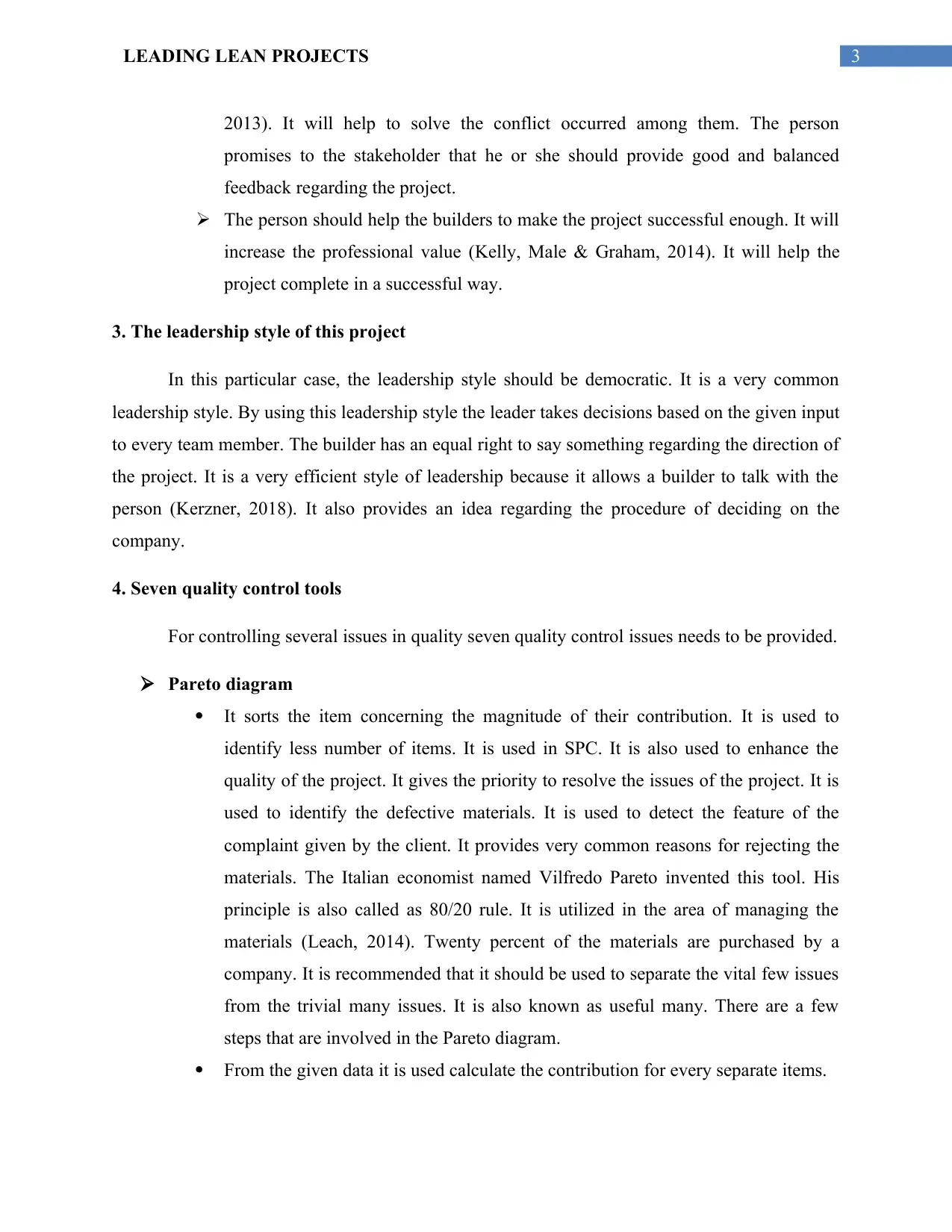
3LEADING LEAN PROJECTS
2013). It will help to solve the conflict occurred among them. The person
promises to the stakeholder that he or she should provide good and balanced
feedback regarding the project.
The person should help the builders to make the project successful enough. It will
increase the professional value (Kelly, Male & Graham, 2014). It will help the
project complete in a successful way.
3. The leadership style of this project
In this particular case, the leadership style should be democratic. It is a very common
leadership style. By using this leadership style the leader takes decisions based on the given input
to every team member. The builder has an equal right to say something regarding the direction of
the project. It is a very efficient style of leadership because it allows a builder to talk with the
person (Kerzner, 2018). It also provides an idea regarding the procedure of deciding on the
company.
4. Seven quality control tools
For controlling several issues in quality seven quality control issues needs to be provided.
Pareto diagram
It sorts the item concerning the magnitude of their contribution. It is used to
identify less number of items. It is used in SPC. It is also used to enhance the
quality of the project. It gives the priority to resolve the issues of the project. It is
used to identify the defective materials. It is used to detect the feature of the
complaint given by the client. It provides very common reasons for rejecting the
materials. The Italian economist named Vilfredo Pareto invented this tool. His
principle is also called as 80/20 rule. It is utilized in the area of managing the
materials (Leach, 2014). Twenty percent of the materials are purchased by a
company. It is recommended that it should be used to separate the vital few issues
from the trivial many issues. It is also known as useful many. There are a few
steps that are involved in the Pareto diagram.
From the given data it is used calculate the contribution for every separate items.
2013). It will help to solve the conflict occurred among them. The person
promises to the stakeholder that he or she should provide good and balanced
feedback regarding the project.
The person should help the builders to make the project successful enough. It will
increase the professional value (Kelly, Male & Graham, 2014). It will help the
project complete in a successful way.
3. The leadership style of this project
In this particular case, the leadership style should be democratic. It is a very common
leadership style. By using this leadership style the leader takes decisions based on the given input
to every team member. The builder has an equal right to say something regarding the direction of
the project. It is a very efficient style of leadership because it allows a builder to talk with the
person (Kerzner, 2018). It also provides an idea regarding the procedure of deciding on the
company.
4. Seven quality control tools
For controlling several issues in quality seven quality control issues needs to be provided.
Pareto diagram
It sorts the item concerning the magnitude of their contribution. It is used to
identify less number of items. It is used in SPC. It is also used to enhance the
quality of the project. It gives the priority to resolve the issues of the project. It is
used to identify the defective materials. It is used to detect the feature of the
complaint given by the client. It provides very common reasons for rejecting the
materials. The Italian economist named Vilfredo Pareto invented this tool. His
principle is also called as 80/20 rule. It is utilized in the area of managing the
materials (Leach, 2014). Twenty percent of the materials are purchased by a
company. It is recommended that it should be used to separate the vital few issues
from the trivial many issues. It is also known as useful many. There are a few
steps that are involved in the Pareto diagram.
From the given data it is used calculate the contribution for every separate items.
Secure Best Marks with AI Grader
Need help grading? Try our AI Grader for instant feedback on your assignments.
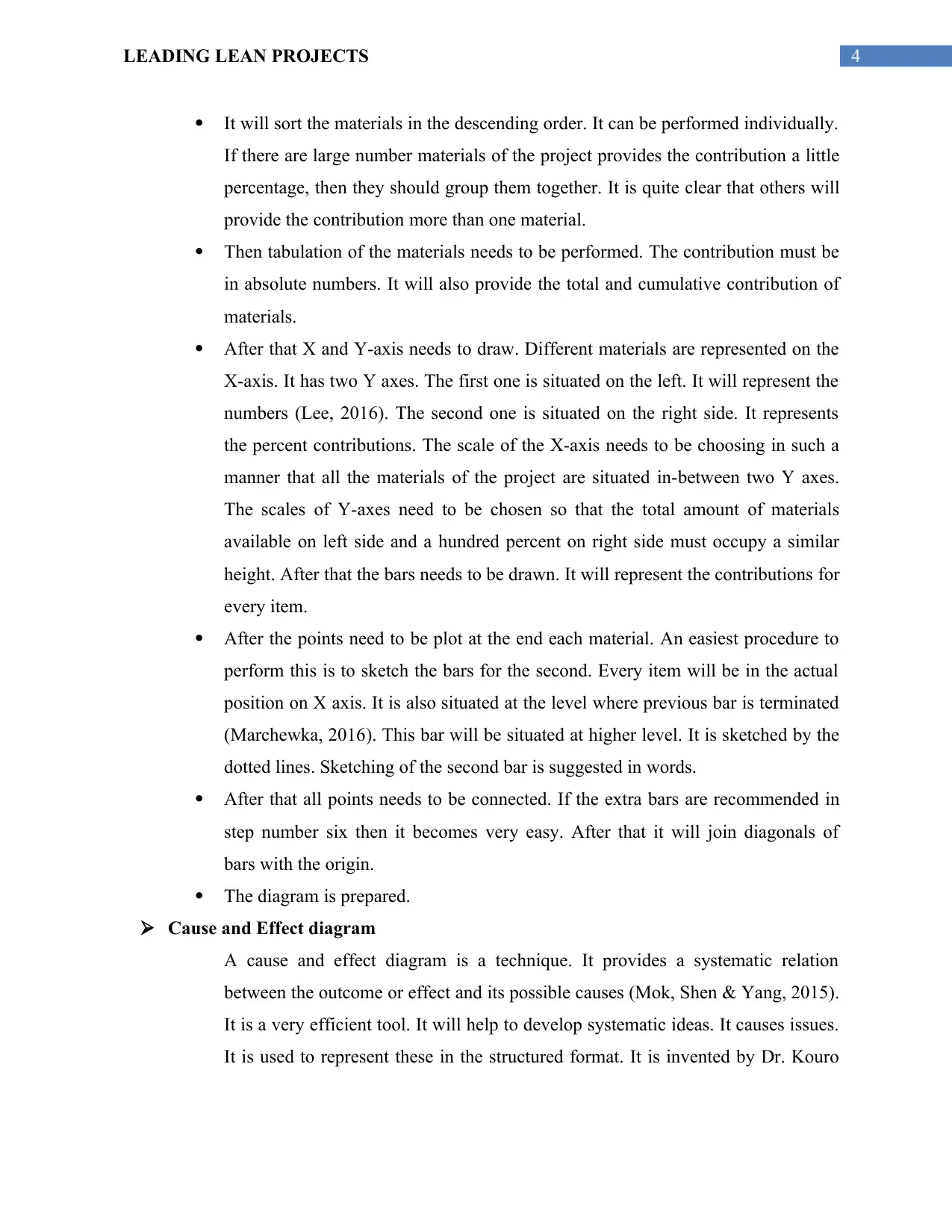
4LEADING LEAN PROJECTS
It will sort the materials in the descending order. It can be performed individually.
If there are large number materials of the project provides the contribution a little
percentage, then they should group them together. It is quite clear that others will
provide the contribution more than one material.
Then tabulation of the materials needs to be performed. The contribution must be
in absolute numbers. It will also provide the total and cumulative contribution of
materials.
After that X and Y-axis needs to draw. Different materials are represented on the
X-axis. It has two Y axes. The first one is situated on the left. It will represent the
numbers (Lee, 2016). The second one is situated on the right side. It represents
the percent contributions. The scale of the X-axis needs to be choosing in such a
manner that all the materials of the project are situated in-between two Y axes.
The scales of Y-axes need to be chosen so that the total amount of materials
available on left side and a hundred percent on right side must occupy a similar
height. After that the bars needs to be drawn. It will represent the contributions for
every item.
After the points need to be plot at the end each material. An easiest procedure to
perform this is to sketch the bars for the second. Every item will be in the actual
position on X axis. It is also situated at the level where previous bar is terminated
(Marchewka, 2016). This bar will be situated at higher level. It is sketched by the
dotted lines. Sketching of the second bar is suggested in words.
After that all points needs to be connected. If the extra bars are recommended in
step number six then it becomes very easy. After that it will join diagonals of
bars with the origin.
The diagram is prepared.
Cause and Effect diagram
A cause and effect diagram is a technique. It provides a systematic relation
between the outcome or effect and its possible causes (Mok, Shen & Yang, 2015).
It is a very efficient tool. It will help to develop systematic ideas. It causes issues.
It is used to represent these in the structured format. It is invented by Dr. Kouro
It will sort the materials in the descending order. It can be performed individually.
If there are large number materials of the project provides the contribution a little
percentage, then they should group them together. It is quite clear that others will
provide the contribution more than one material.
Then tabulation of the materials needs to be performed. The contribution must be
in absolute numbers. It will also provide the total and cumulative contribution of
materials.
After that X and Y-axis needs to draw. Different materials are represented on the
X-axis. It has two Y axes. The first one is situated on the left. It will represent the
numbers (Lee, 2016). The second one is situated on the right side. It represents
the percent contributions. The scale of the X-axis needs to be choosing in such a
manner that all the materials of the project are situated in-between two Y axes.
The scales of Y-axes need to be chosen so that the total amount of materials
available on left side and a hundred percent on right side must occupy a similar
height. After that the bars needs to be drawn. It will represent the contributions for
every item.
After the points need to be plot at the end each material. An easiest procedure to
perform this is to sketch the bars for the second. Every item will be in the actual
position on X axis. It is also situated at the level where previous bar is terminated
(Marchewka, 2016). This bar will be situated at higher level. It is sketched by the
dotted lines. Sketching of the second bar is suggested in words.
After that all points needs to be connected. If the extra bars are recommended in
step number six then it becomes very easy. After that it will join diagonals of
bars with the origin.
The diagram is prepared.
Cause and Effect diagram
A cause and effect diagram is a technique. It provides a systematic relation
between the outcome or effect and its possible causes (Mok, Shen & Yang, 2015).
It is a very efficient tool. It will help to develop systematic ideas. It causes issues.
It is used to represent these in the structured format. It is invented by Dr. Kouro
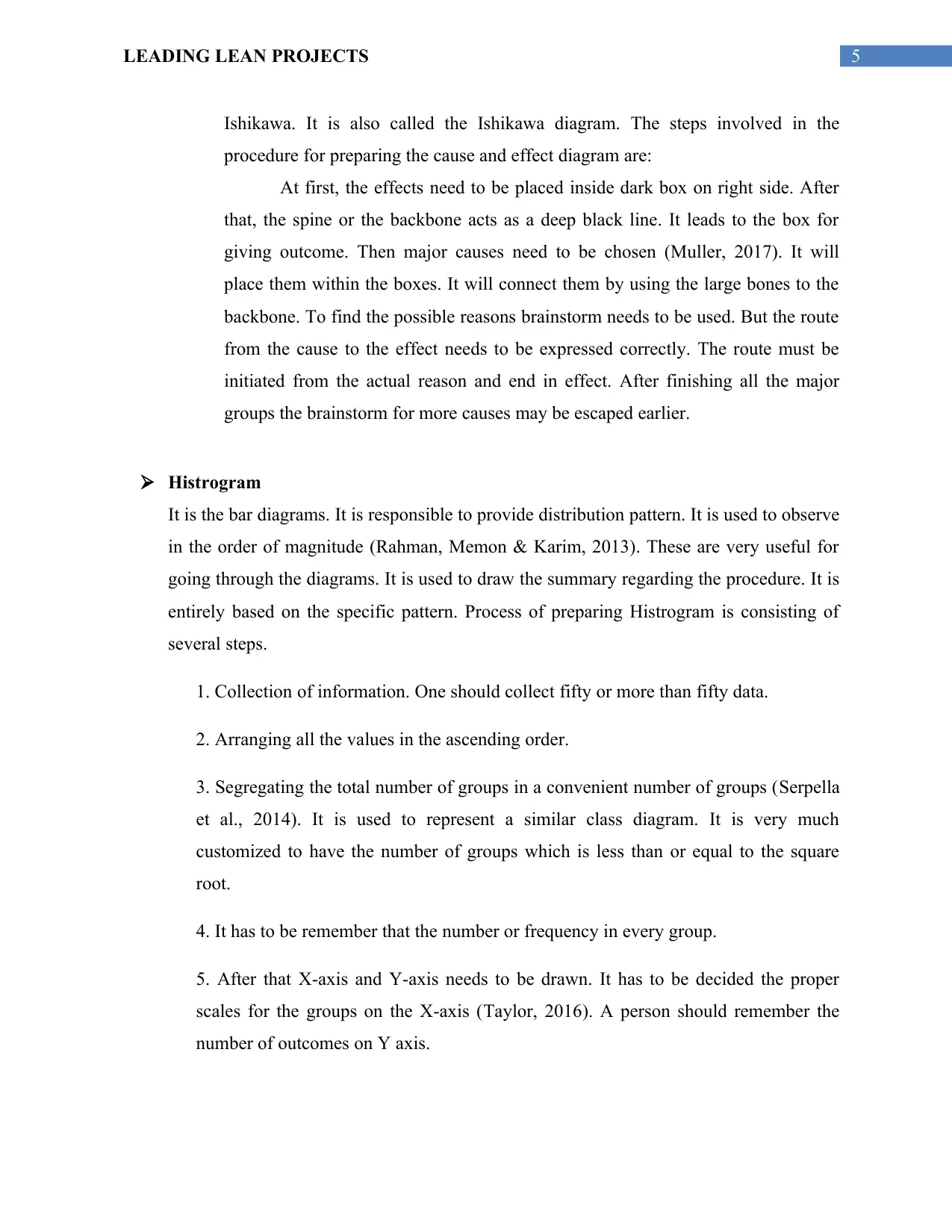
5LEADING LEAN PROJECTS
Ishikawa. It is also called the Ishikawa diagram. The steps involved in the
procedure for preparing the cause and effect diagram are:
At first, the effects need to be placed inside dark box on right side. After
that, the spine or the backbone acts as a deep black line. It leads to the box for
giving outcome. Then major causes need to be chosen (Muller, 2017). It will
place them within the boxes. It will connect them by using the large bones to the
backbone. To find the possible reasons brainstorm needs to be used. But the route
from the cause to the effect needs to be expressed correctly. The route must be
initiated from the actual reason and end in effect. After finishing all the major
groups the brainstorm for more causes may be escaped earlier.
Histrogram
It is the bar diagrams. It is responsible to provide distribution pattern. It is used to observe
in the order of magnitude (Rahman, Memon & Karim, 2013). These are very useful for
going through the diagrams. It is used to draw the summary regarding the procedure. It is
entirely based on the specific pattern. Process of preparing Histrogram is consisting of
several steps.
1. Collection of information. One should collect fifty or more than fifty data.
2. Arranging all the values in the ascending order.
3. Segregating the total number of groups in a convenient number of groups (Serpella
et al., 2014). It is used to represent a similar class diagram. It is very much
customized to have the number of groups which is less than or equal to the square
root.
4. It has to be remember that the number or frequency in every group.
5. After that X-axis and Y-axis needs to be drawn. It has to be decided the proper
scales for the groups on the X-axis (Taylor, 2016). A person should remember the
number of outcomes on Y axis.
Ishikawa. It is also called the Ishikawa diagram. The steps involved in the
procedure for preparing the cause and effect diagram are:
At first, the effects need to be placed inside dark box on right side. After
that, the spine or the backbone acts as a deep black line. It leads to the box for
giving outcome. Then major causes need to be chosen (Muller, 2017). It will
place them within the boxes. It will connect them by using the large bones to the
backbone. To find the possible reasons brainstorm needs to be used. But the route
from the cause to the effect needs to be expressed correctly. The route must be
initiated from the actual reason and end in effect. After finishing all the major
groups the brainstorm for more causes may be escaped earlier.
Histrogram
It is the bar diagrams. It is responsible to provide distribution pattern. It is used to observe
in the order of magnitude (Rahman, Memon & Karim, 2013). These are very useful for
going through the diagrams. It is used to draw the summary regarding the procedure. It is
entirely based on the specific pattern. Process of preparing Histrogram is consisting of
several steps.
1. Collection of information. One should collect fifty or more than fifty data.
2. Arranging all the values in the ascending order.
3. Segregating the total number of groups in a convenient number of groups (Serpella
et al., 2014). It is used to represent a similar class diagram. It is very much
customized to have the number of groups which is less than or equal to the square
root.
4. It has to be remember that the number or frequency in every group.
5. After that X-axis and Y-axis needs to be drawn. It has to be decided the proper
scales for the groups on the X-axis (Taylor, 2016). A person should remember the
number of outcomes on Y axis.

6LEADING LEAN PROJECTS
6. After that bars needs to be drawn. These bars represent the frequency for every
group.
7. Then a subtitle of that histogram needs to be provided.
8. After that the pattern needs to be gone through.
9. After that a conclusion needs to be drawn.
Control charts
Variation is very common in this type of project (Too & Weaver, 2014). There are two
different kinds of cause. First one is the Random cause and second is the Assignable
cause. One cannot prevent the random cause, but assignable cause can be preventable. It
is designed by Dr. Walter A. Shewhart. It was developed in the year 1920. He developed
this in the Bell telephone laboratories. In this particular case data is of two types. First
one is variable and second one is Attribute. Variable can be measured and expressed in
quantitative manner. Attribute will be qualitative in nature. Mean and Range are another
important part of mean and range. Mean is denoted by X. It is calculated as average of a
sub-group. Range is denoted by range. It is difference between maximum and minimum
sub group. In case of control charts, Charts describe the variation in –X and R with time.
It is called –X and R charts. –X and R charts are used for the variable data (Verzuh,
2015). The same length of the sub-group will be two to five. If the length of sub-group is
big then S charts must be used. In this particular case, R charts cannot be used. In this
case, S is called standard deviation of the sub-group. The control chart for attributes
consists of p-chart, np-chart, c-chart and u-chart. Control chart for defective portions are
the p as well as np chart. P chart can be used when sample size is fixed.
Scatter diagram
During solving some problems the person needs to remember relation between two
variables. This may or may not exist in-between two variables. If it exists then it may be
positive or negative. The relation can be strong or weak (Zavadskas et al., 2014). It can
be simple or complicated. A scatter diagram is used to go through the relation between
them. It consists of plotting a series of points. There are several observations in the graph.
6. After that bars needs to be drawn. These bars represent the frequency for every
group.
7. Then a subtitle of that histogram needs to be provided.
8. After that the pattern needs to be gone through.
9. After that a conclusion needs to be drawn.
Control charts
Variation is very common in this type of project (Too & Weaver, 2014). There are two
different kinds of cause. First one is the Random cause and second is the Assignable
cause. One cannot prevent the random cause, but assignable cause can be preventable. It
is designed by Dr. Walter A. Shewhart. It was developed in the year 1920. He developed
this in the Bell telephone laboratories. In this particular case data is of two types. First
one is variable and second one is Attribute. Variable can be measured and expressed in
quantitative manner. Attribute will be qualitative in nature. Mean and Range are another
important part of mean and range. Mean is denoted by X. It is calculated as average of a
sub-group. Range is denoted by range. It is difference between maximum and minimum
sub group. In case of control charts, Charts describe the variation in –X and R with time.
It is called –X and R charts. –X and R charts are used for the variable data (Verzuh,
2015). The same length of the sub-group will be two to five. If the length of sub-group is
big then S charts must be used. In this particular case, R charts cannot be used. In this
case, S is called standard deviation of the sub-group. The control chart for attributes
consists of p-chart, np-chart, c-chart and u-chart. Control chart for defective portions are
the p as well as np chart. P chart can be used when sample size is fixed.
Scatter diagram
During solving some problems the person needs to remember relation between two
variables. This may or may not exist in-between two variables. If it exists then it may be
positive or negative. The relation can be strong or weak (Zavadskas et al., 2014). It can
be simple or complicated. A scatter diagram is used to go through the relation between
them. It consists of plotting a series of points. There are several observations in the graph.
Paraphrase This Document
Need a fresh take? Get an instant paraphrase of this document with our AI Paraphraser
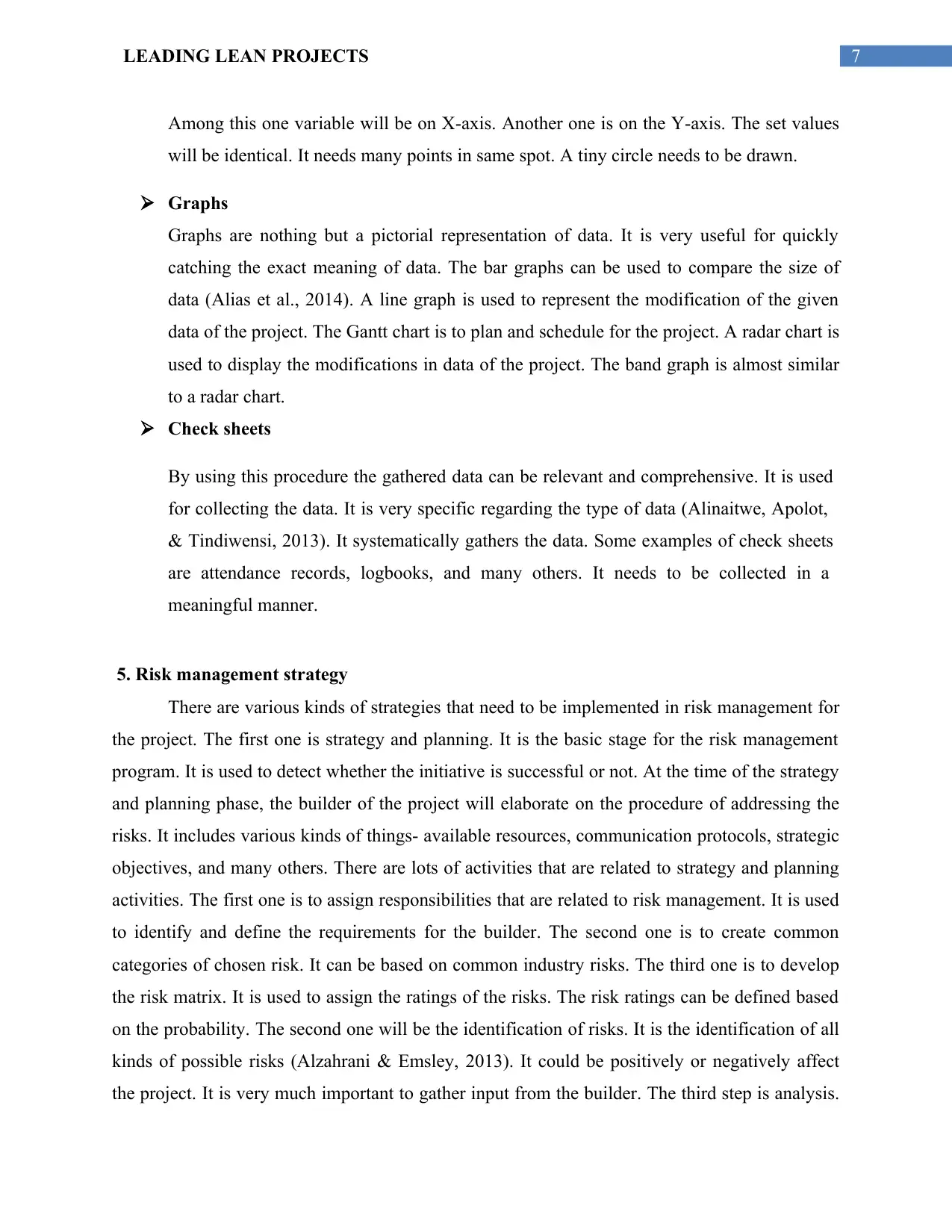
7LEADING LEAN PROJECTS
Among this one variable will be on X-axis. Another one is on the Y-axis. The set values
will be identical. It needs many points in same spot. A tiny circle needs to be drawn.
Graphs
Graphs are nothing but a pictorial representation of data. It is very useful for quickly
catching the exact meaning of data. The bar graphs can be used to compare the size of
data (Alias et al., 2014). A line graph is used to represent the modification of the given
data of the project. The Gantt chart is to plan and schedule for the project. A radar chart is
used to display the modifications in data of the project. The band graph is almost similar
to a radar chart.
Check sheets
By using this procedure the gathered data can be relevant and comprehensive. It is used
for collecting the data. It is very specific regarding the type of data (Alinaitwe, Apolot,
& Tindiwensi, 2013). It systematically gathers the data. Some examples of check sheets
are attendance records, logbooks, and many others. It needs to be collected in a
meaningful manner.
5. Risk management strategy
There are various kinds of strategies that need to be implemented in risk management for
the project. The first one is strategy and planning. It is the basic stage for the risk management
program. It is used to detect whether the initiative is successful or not. At the time of the strategy
and planning phase, the builder of the project will elaborate on the procedure of addressing the
risks. It includes various kinds of things- available resources, communication protocols, strategic
objectives, and many others. There are lots of activities that are related to strategy and planning
activities. The first one is to assign responsibilities that are related to risk management. It is used
to identify and define the requirements for the builder. The second one is to create common
categories of chosen risk. It can be based on common industry risks. The third one is to develop
the risk matrix. It is used to assign the ratings of the risks. The risk ratings can be defined based
on the probability. The second one will be the identification of risks. It is the identification of all
kinds of possible risks (Alzahrani & Emsley, 2013). It could be positively or negatively affect
the project. It is very much important to gather input from the builder. The third step is analysis.
Among this one variable will be on X-axis. Another one is on the Y-axis. The set values
will be identical. It needs many points in same spot. A tiny circle needs to be drawn.
Graphs
Graphs are nothing but a pictorial representation of data. It is very useful for quickly
catching the exact meaning of data. The bar graphs can be used to compare the size of
data (Alias et al., 2014). A line graph is used to represent the modification of the given
data of the project. The Gantt chart is to plan and schedule for the project. A radar chart is
used to display the modifications in data of the project. The band graph is almost similar
to a radar chart.
Check sheets
By using this procedure the gathered data can be relevant and comprehensive. It is used
for collecting the data. It is very specific regarding the type of data (Alinaitwe, Apolot,
& Tindiwensi, 2013). It systematically gathers the data. Some examples of check sheets
are attendance records, logbooks, and many others. It needs to be collected in a
meaningful manner.
5. Risk management strategy
There are various kinds of strategies that need to be implemented in risk management for
the project. The first one is strategy and planning. It is the basic stage for the risk management
program. It is used to detect whether the initiative is successful or not. At the time of the strategy
and planning phase, the builder of the project will elaborate on the procedure of addressing the
risks. It includes various kinds of things- available resources, communication protocols, strategic
objectives, and many others. There are lots of activities that are related to strategy and planning
activities. The first one is to assign responsibilities that are related to risk management. It is used
to identify and define the requirements for the builder. The second one is to create common
categories of chosen risk. It can be based on common industry risks. The third one is to develop
the risk matrix. It is used to assign the ratings of the risks. The risk ratings can be defined based
on the probability. The second one will be the identification of risks. It is the identification of all
kinds of possible risks (Alzahrani & Emsley, 2013). It could be positively or negatively affect
the project. It is very much important to gather input from the builder. The third step is analysis.
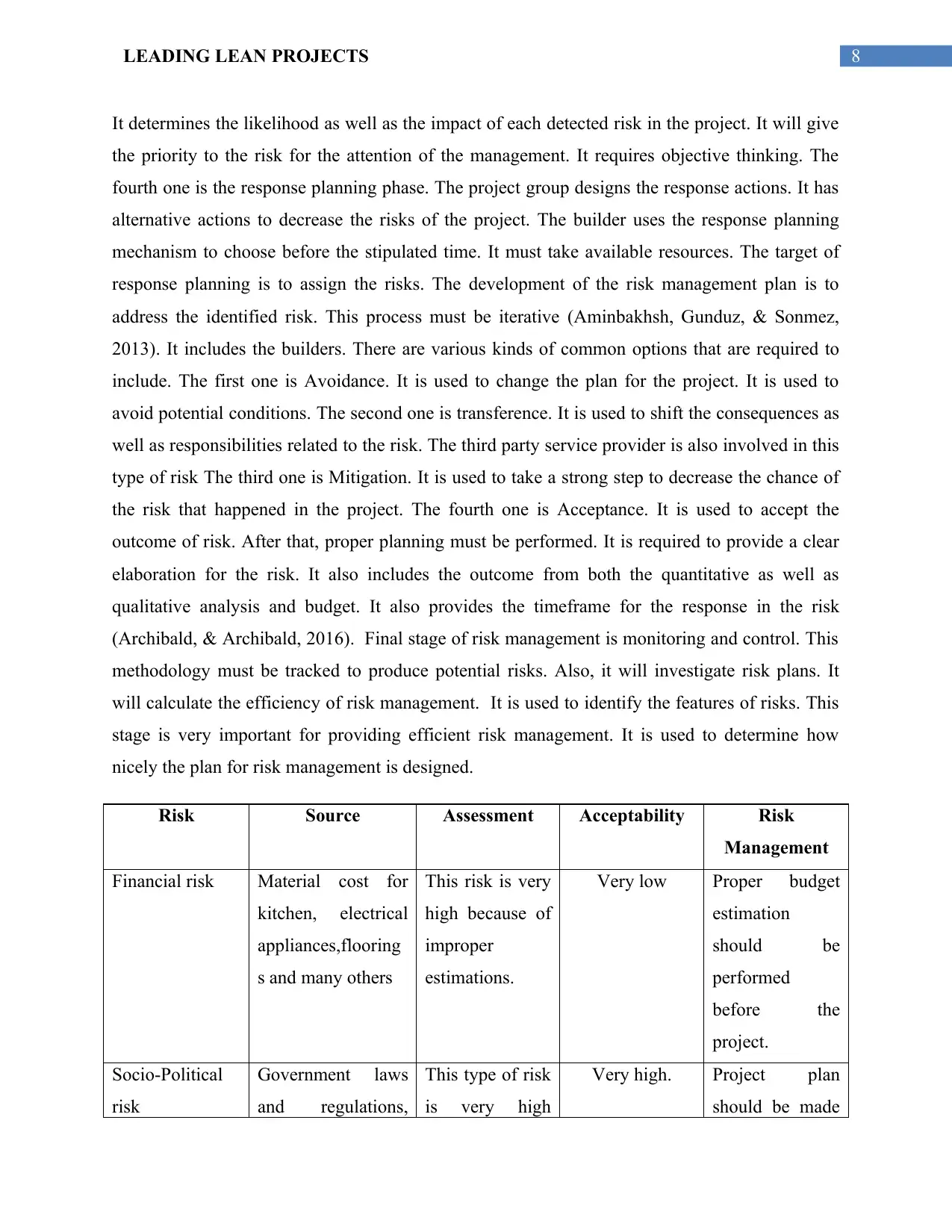
8LEADING LEAN PROJECTS
It determines the likelihood as well as the impact of each detected risk in the project. It will give
the priority to the risk for the attention of the management. It requires objective thinking. The
fourth one is the response planning phase. The project group designs the response actions. It has
alternative actions to decrease the risks of the project. The builder uses the response planning
mechanism to choose before the stipulated time. It must take available resources. The target of
response planning is to assign the risks. The development of the risk management plan is to
address the identified risk. This process must be iterative (Aminbakhsh, Gunduz, & Sonmez,
2013). It includes the builders. There are various kinds of common options that are required to
include. The first one is Avoidance. It is used to change the plan for the project. It is used to
avoid potential conditions. The second one is transference. It is used to shift the consequences as
well as responsibilities related to the risk. The third party service provider is also involved in this
type of risk The third one is Mitigation. It is used to take a strong step to decrease the chance of
the risk that happened in the project. The fourth one is Acceptance. It is used to accept the
outcome of risk. After that, proper planning must be performed. It is required to provide a clear
elaboration for the risk. It also includes the outcome from both the quantitative as well as
qualitative analysis and budget. It also provides the timeframe for the response in the risk
(Archibald, & Archibald, 2016). Final stage of risk management is monitoring and control. This
methodology must be tracked to produce potential risks. Also, it will investigate risk plans. It
will calculate the efficiency of risk management. It is used to identify the features of risks. This
stage is very important for providing efficient risk management. It is used to determine how
nicely the plan for risk management is designed.
Risk Source Assessment Acceptability Risk
Management
Financial risk Material cost for
kitchen, electrical
appliances,flooring
s and many others
This risk is very
high because of
improper
estimations.
Very low Proper budget
estimation
should be
performed
before the
project.
Socio-Political
risk
Government laws
and regulations,
This type of risk
is very high
Very high. Project plan
should be made
It determines the likelihood as well as the impact of each detected risk in the project. It will give
the priority to the risk for the attention of the management. It requires objective thinking. The
fourth one is the response planning phase. The project group designs the response actions. It has
alternative actions to decrease the risks of the project. The builder uses the response planning
mechanism to choose before the stipulated time. It must take available resources. The target of
response planning is to assign the risks. The development of the risk management plan is to
address the identified risk. This process must be iterative (Aminbakhsh, Gunduz, & Sonmez,
2013). It includes the builders. There are various kinds of common options that are required to
include. The first one is Avoidance. It is used to change the plan for the project. It is used to
avoid potential conditions. The second one is transference. It is used to shift the consequences as
well as responsibilities related to the risk. The third party service provider is also involved in this
type of risk The third one is Mitigation. It is used to take a strong step to decrease the chance of
the risk that happened in the project. The fourth one is Acceptance. It is used to accept the
outcome of risk. After that, proper planning must be performed. It is required to provide a clear
elaboration for the risk. It also includes the outcome from both the quantitative as well as
qualitative analysis and budget. It also provides the timeframe for the response in the risk
(Archibald, & Archibald, 2016). Final stage of risk management is monitoring and control. This
methodology must be tracked to produce potential risks. Also, it will investigate risk plans. It
will calculate the efficiency of risk management. It is used to identify the features of risks. This
stage is very important for providing efficient risk management. It is used to determine how
nicely the plan for risk management is designed.
Risk Source Assessment Acceptability Risk
Management
Financial risk Material cost for
kitchen, electrical
appliances,flooring
s and many others
This risk is very
high because of
improper
estimations.
Very low Proper budget
estimation
should be
performed
before the
project.
Socio-Political
risk
Government laws
and regulations,
This type of risk
is very high
Very high. Project plan
should be made
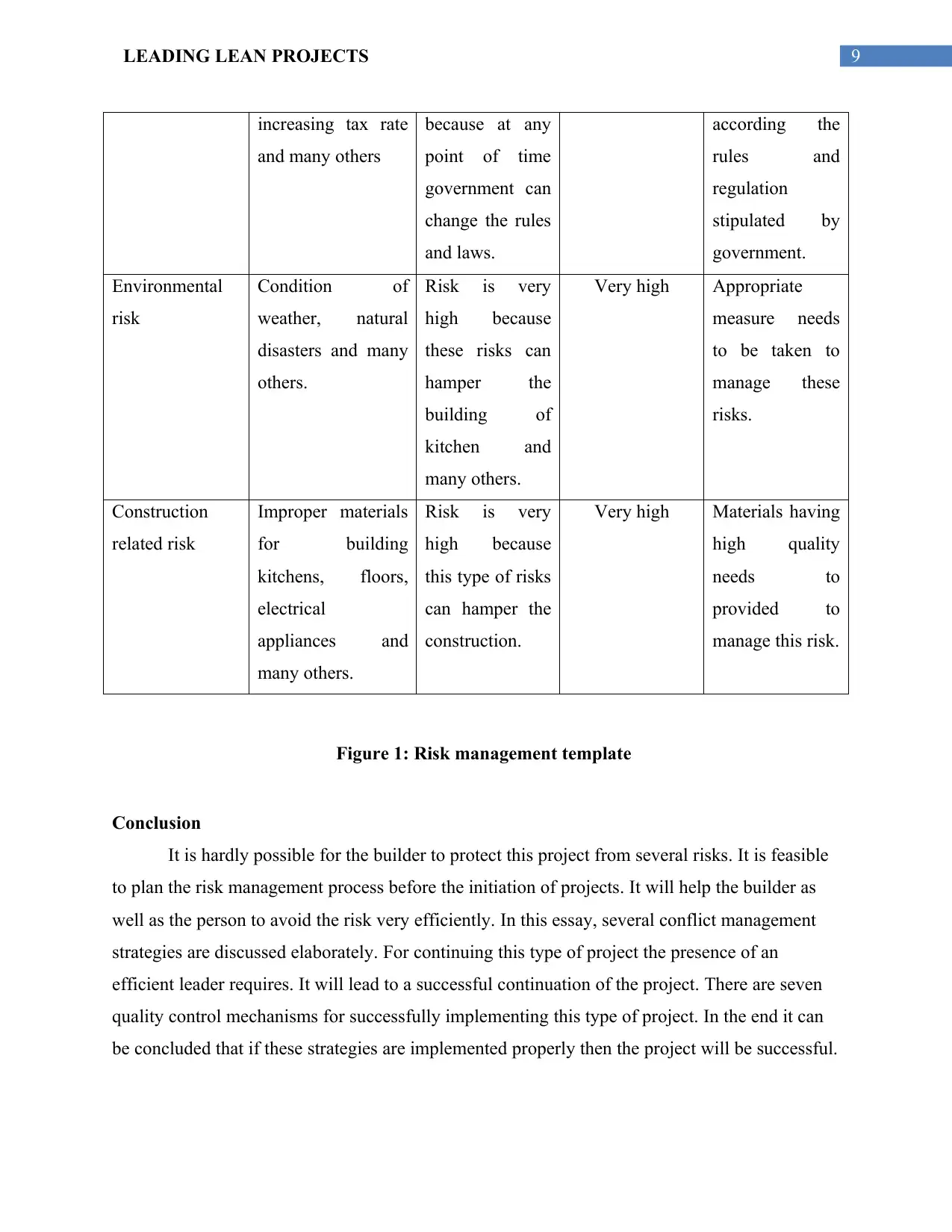
9LEADING LEAN PROJECTS
increasing tax rate
and many others
because at any
point of time
government can
change the rules
and laws.
according the
rules and
regulation
stipulated by
government.
Environmental
risk
Condition of
weather, natural
disasters and many
others.
Risk is very
high because
these risks can
hamper the
building of
kitchen and
many others.
Very high Appropriate
measure needs
to be taken to
manage these
risks.
Construction
related risk
Improper materials
for building
kitchens, floors,
electrical
appliances and
many others.
Risk is very
high because
this type of risks
can hamper the
construction.
Very high Materials having
high quality
needs to
provided to
manage this risk.
Figure 1: Risk management template
Conclusion
It is hardly possible for the builder to protect this project from several risks. It is feasible
to plan the risk management process before the initiation of projects. It will help the builder as
well as the person to avoid the risk very efficiently. In this essay, several conflict management
strategies are discussed elaborately. For continuing this type of project the presence of an
efficient leader requires. It will lead to a successful continuation of the project. There are seven
quality control mechanisms for successfully implementing this type of project. In the end it can
be concluded that if these strategies are implemented properly then the project will be successful.
increasing tax rate
and many others
because at any
point of time
government can
change the rules
and laws.
according the
rules and
regulation
stipulated by
government.
Environmental
risk
Condition of
weather, natural
disasters and many
others.
Risk is very
high because
these risks can
hamper the
building of
kitchen and
many others.
Very high Appropriate
measure needs
to be taken to
manage these
risks.
Construction
related risk
Improper materials
for building
kitchens, floors,
electrical
appliances and
many others.
Risk is very
high because
this type of risks
can hamper the
construction.
Very high Materials having
high quality
needs to
provided to
manage this risk.
Figure 1: Risk management template
Conclusion
It is hardly possible for the builder to protect this project from several risks. It is feasible
to plan the risk management process before the initiation of projects. It will help the builder as
well as the person to avoid the risk very efficiently. In this essay, several conflict management
strategies are discussed elaborately. For continuing this type of project the presence of an
efficient leader requires. It will lead to a successful continuation of the project. There are seven
quality control mechanisms for successfully implementing this type of project. In the end it can
be concluded that if these strategies are implemented properly then the project will be successful.
Secure Best Marks with AI Grader
Need help grading? Try our AI Grader for instant feedback on your assignments.
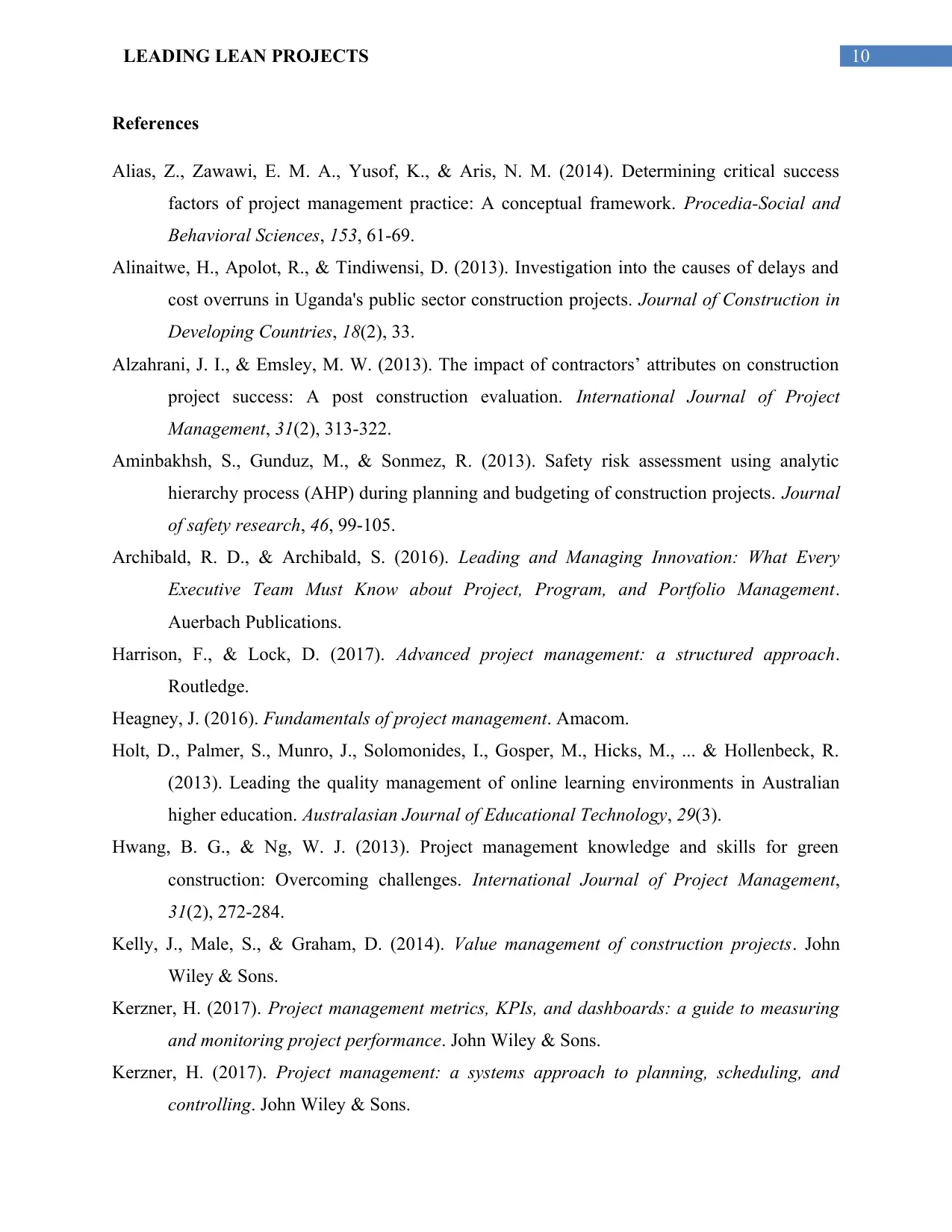
10LEADING LEAN PROJECTS
References
Alias, Z., Zawawi, E. M. A., Yusof, K., & Aris, N. M. (2014). Determining critical success
factors of project management practice: A conceptual framework. Procedia-Social and
Behavioral Sciences, 153, 61-69.
Alinaitwe, H., Apolot, R., & Tindiwensi, D. (2013). Investigation into the causes of delays and
cost overruns in Uganda's public sector construction projects. Journal of Construction in
Developing Countries, 18(2), 33.
Alzahrani, J. I., & Emsley, M. W. (2013). The impact of contractors’ attributes on construction
project success: A post construction evaluation. International Journal of Project
Management, 31(2), 313-322.
Aminbakhsh, S., Gunduz, M., & Sonmez, R. (2013). Safety risk assessment using analytic
hierarchy process (AHP) during planning and budgeting of construction projects. Journal
of safety research, 46, 99-105.
Archibald, R. D., & Archibald, S. (2016). Leading and Managing Innovation: What Every
Executive Team Must Know about Project, Program, and Portfolio Management.
Auerbach Publications.
Harrison, F., & Lock, D. (2017). Advanced project management: a structured approach.
Routledge.
Heagney, J. (2016). Fundamentals of project management. Amacom.
Holt, D., Palmer, S., Munro, J., Solomonides, I., Gosper, M., Hicks, M., ... & Hollenbeck, R.
(2013). Leading the quality management of online learning environments in Australian
higher education. Australasian Journal of Educational Technology, 29(3).
Hwang, B. G., & Ng, W. J. (2013). Project management knowledge and skills for green
construction: Overcoming challenges. International Journal of Project Management,
31(2), 272-284.
Kelly, J., Male, S., & Graham, D. (2014). Value management of construction projects. John
Wiley & Sons.
Kerzner, H. (2017). Project management metrics, KPIs, and dashboards: a guide to measuring
and monitoring project performance. John Wiley & Sons.
Kerzner, H. (2017). Project management: a systems approach to planning, scheduling, and
controlling. John Wiley & Sons.
References
Alias, Z., Zawawi, E. M. A., Yusof, K., & Aris, N. M. (2014). Determining critical success
factors of project management practice: A conceptual framework. Procedia-Social and
Behavioral Sciences, 153, 61-69.
Alinaitwe, H., Apolot, R., & Tindiwensi, D. (2013). Investigation into the causes of delays and
cost overruns in Uganda's public sector construction projects. Journal of Construction in
Developing Countries, 18(2), 33.
Alzahrani, J. I., & Emsley, M. W. (2013). The impact of contractors’ attributes on construction
project success: A post construction evaluation. International Journal of Project
Management, 31(2), 313-322.
Aminbakhsh, S., Gunduz, M., & Sonmez, R. (2013). Safety risk assessment using analytic
hierarchy process (AHP) during planning and budgeting of construction projects. Journal
of safety research, 46, 99-105.
Archibald, R. D., & Archibald, S. (2016). Leading and Managing Innovation: What Every
Executive Team Must Know about Project, Program, and Portfolio Management.
Auerbach Publications.
Harrison, F., & Lock, D. (2017). Advanced project management: a structured approach.
Routledge.
Heagney, J. (2016). Fundamentals of project management. Amacom.
Holt, D., Palmer, S., Munro, J., Solomonides, I., Gosper, M., Hicks, M., ... & Hollenbeck, R.
(2013). Leading the quality management of online learning environments in Australian
higher education. Australasian Journal of Educational Technology, 29(3).
Hwang, B. G., & Ng, W. J. (2013). Project management knowledge and skills for green
construction: Overcoming challenges. International Journal of Project Management,
31(2), 272-284.
Kelly, J., Male, S., & Graham, D. (2014). Value management of construction projects. John
Wiley & Sons.
Kerzner, H. (2017). Project management metrics, KPIs, and dashboards: a guide to measuring
and monitoring project performance. John Wiley & Sons.
Kerzner, H. (2017). Project management: a systems approach to planning, scheduling, and
controlling. John Wiley & Sons.
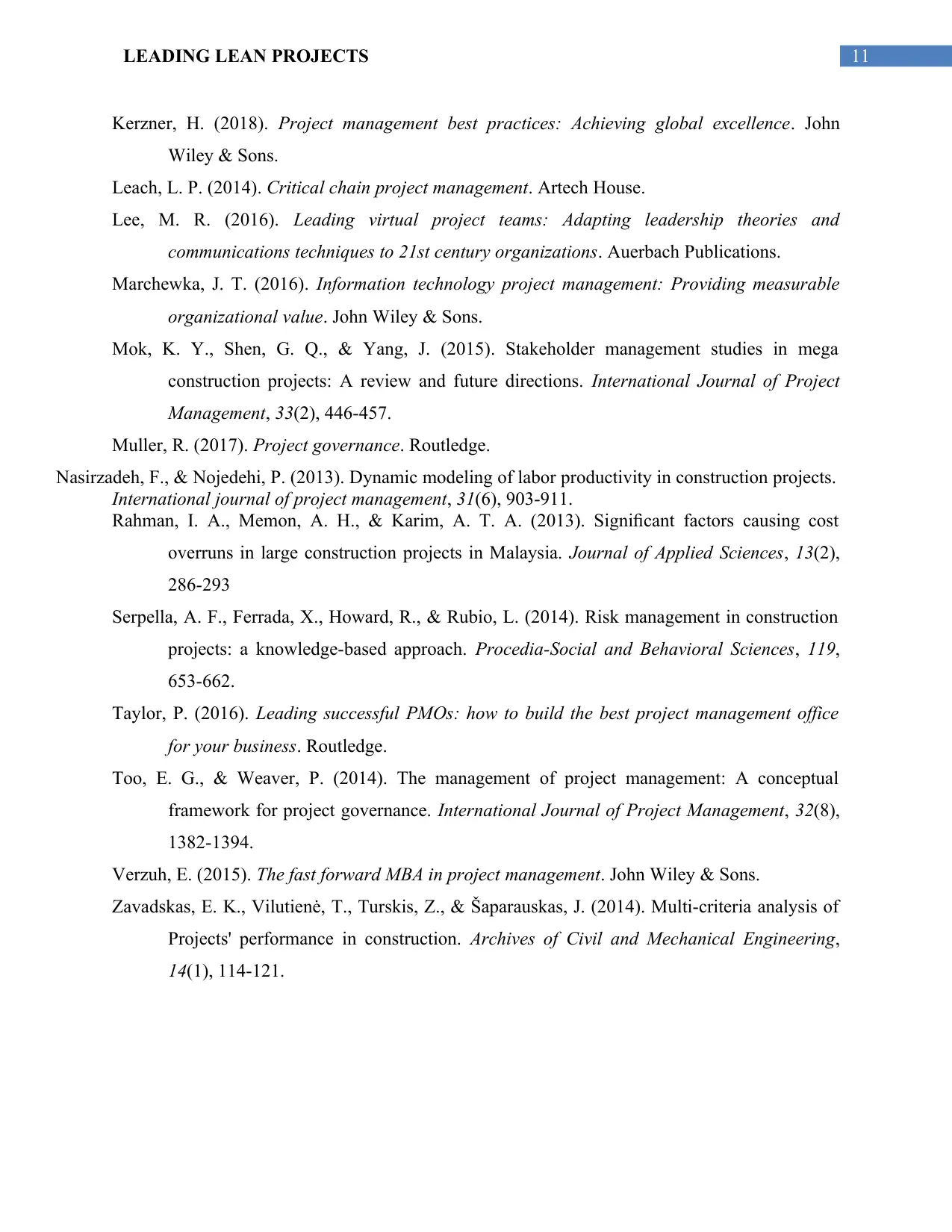
11LEADING LEAN PROJECTS
Kerzner, H. (2018). Project management best practices: Achieving global excellence. John
Wiley & Sons.
Leach, L. P. (2014). Critical chain project management. Artech House.
Lee, M. R. (2016). Leading virtual project teams: Adapting leadership theories and
communications techniques to 21st century organizations. Auerbach Publications.
Marchewka, J. T. (2016). Information technology project management: Providing measurable
organizational value. John Wiley & Sons.
Mok, K. Y., Shen, G. Q., & Yang, J. (2015). Stakeholder management studies in mega
construction projects: A review and future directions. International Journal of Project
Management, 33(2), 446-457.
Muller, R. (2017). Project governance. Routledge.
Nasirzadeh, F., & Nojedehi, P. (2013). Dynamic modeling of labor productivity in construction projects.
International journal of project management, 31(6), 903-911.
Rahman, I. A., Memon, A. H., & Karim, A. T. A. (2013). Significant factors causing cost
overruns in large construction projects in Malaysia. Journal of Applied Sciences, 13(2),
286-293
Serpella, A. F., Ferrada, X., Howard, R., & Rubio, L. (2014). Risk management in construction
projects: a knowledge-based approach. Procedia-Social and Behavioral Sciences, 119,
653-662.
Taylor, P. (2016). Leading successful PMOs: how to build the best project management office
for your business. Routledge.
Too, E. G., & Weaver, P. (2014). The management of project management: A conceptual
framework for project governance. International Journal of Project Management, 32(8),
1382-1394.
Verzuh, E. (2015). The fast forward MBA in project management. John Wiley & Sons.
Zavadskas, E. K., Vilutienė, T., Turskis, Z., & Šaparauskas, J. (2014). Multi-criteria analysis of
Projects' performance in construction. Archives of Civil and Mechanical Engineering,
14(1), 114-121.
Kerzner, H. (2018). Project management best practices: Achieving global excellence. John
Wiley & Sons.
Leach, L. P. (2014). Critical chain project management. Artech House.
Lee, M. R. (2016). Leading virtual project teams: Adapting leadership theories and
communications techniques to 21st century organizations. Auerbach Publications.
Marchewka, J. T. (2016). Information technology project management: Providing measurable
organizational value. John Wiley & Sons.
Mok, K. Y., Shen, G. Q., & Yang, J. (2015). Stakeholder management studies in mega
construction projects: A review and future directions. International Journal of Project
Management, 33(2), 446-457.
Muller, R. (2017). Project governance. Routledge.
Nasirzadeh, F., & Nojedehi, P. (2013). Dynamic modeling of labor productivity in construction projects.
International journal of project management, 31(6), 903-911.
Rahman, I. A., Memon, A. H., & Karim, A. T. A. (2013). Significant factors causing cost
overruns in large construction projects in Malaysia. Journal of Applied Sciences, 13(2),
286-293
Serpella, A. F., Ferrada, X., Howard, R., & Rubio, L. (2014). Risk management in construction
projects: a knowledge-based approach. Procedia-Social and Behavioral Sciences, 119,
653-662.
Taylor, P. (2016). Leading successful PMOs: how to build the best project management office
for your business. Routledge.
Too, E. G., & Weaver, P. (2014). The management of project management: A conceptual
framework for project governance. International Journal of Project Management, 32(8),
1382-1394.
Verzuh, E. (2015). The fast forward MBA in project management. John Wiley & Sons.
Zavadskas, E. K., Vilutienė, T., Turskis, Z., & Šaparauskas, J. (2014). Multi-criteria analysis of
Projects' performance in construction. Archives of Civil and Mechanical Engineering,
14(1), 114-121.
1 out of 12
Related Documents
Your All-in-One AI-Powered Toolkit for Academic Success.
+13062052269
info@desklib.com
Available 24*7 on WhatsApp / Email
![[object Object]](/_next/static/media/star-bottom.7253800d.svg)
Unlock your academic potential
© 2024 | Zucol Services PVT LTD | All rights reserved.





